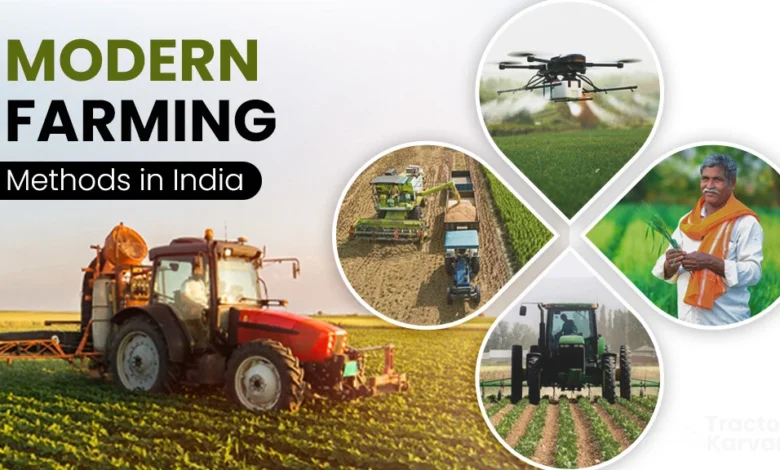
The term “modern farming” or “modern agriculture” describes the application of cutting-edge tools, techniques, and technologies to boost output and efficiency. It entails implementing scientific and technological advancements in farming methods in order to increase yields and lessen agriculture’s negative environmental effects.
In addition, modern agriculture incorporates methods like regenerative agriculture, which builds soil health and biodiversity to support sustainable farming practices, and organic farming, which forgoes the use of artificial fertilizers and pesticides.
Farmers can now cultivate more food with less land, water, and other resources thanks to these techniques, which have developed over time. Following, we are showing the top 10 types of Modern farming practices in India.
10 Types of Modern Farming Practices
In India, a wide variety of modern farming methods are in demand. Precision farming, hydroponics, greenhouses, genetically modified crops, organic farming, regenerative agriculture, and genetically modified crops are a few of the methods used in modern agriculture. In this blog, let’s take a quick look at these kinds.
Organic Farming
Organic farming approaches are becoming more and more popular among Indian farmers today. Instead of using artificial chemicals or genetically modified organisms (GMOs), this approach emphasizes environmentally friendly and sustainable practices. Not only does organic farming yield safer and healthier food, but it also maintains biodiversity and soil fertility. Furthermore, the market values organic produce higher, resulting in higher profits for farmers. You can also use a John Deere mini Tractor for your organic orchard farming. It is an advanced Kubota mini tractor price is budget-friendly.
Crop Rotation
The process of growing a variety of crops in the same spot over a number of growing seasons known as crop rotation. By using this technique, crops become less dependent on a single source of nutrients, weed and pest pressure, and the likelihood that resistant weeds and pests will emerge decreases.
Besides, Monocropping, or growing the same crop in the same spot year after year, gradually depletes the soil of some nutrients and favours a community of weeds and pests that are fiercely competitive. Monoculture productivity depends heavily on outside inputs that could degrade the fertility of the soil if nutrient use is not balanced and pest and weed communities are not diversified.
Extensive Farming
The amount of land that was exploited and the amount of labour-intensive farming involved in managing that exploitation was measured.
Additionally, a three-acre farm with five cattle raised for beef production is an example of extensive farming. The infrastructure of the farm needs to be maintained, and the farmer must ensure the health of the cattle. Still, compared to many other farms, the labour input is minimal because the cows can essentially take care of themselves.
Hydroponics
Growing plants hydroponically involves using a water-based nutrient solution in place of soil, along with an aggregate substrate or growing media like perlite, vermiculite, or coconut coir. Commercial enterprises, hobbyists, and small farmers all use hydroponic production systems.
Precision Farming
The science of enhancing crop yields and supporting management choices with advanced sensor and analysis tools known as precision agriculture or PA. Hence, the world has embraced PA, a novel idea that promises to boost output, cut down on labour costs, and guarantee efficient management of irrigation and fertilizer systems.
Commercial Farming
One kind of farming is based on a business model called commercial farming. Livestock and crops raised for export, sales, and profit. The production of the most sought-after and marketable products maximized through the use of large capital, machinery, and contemporary chemical interventions. Along with this, many high-tech tractor implements are available in the market nowadays, so for commercial farming, you can consider making your work smooth.
Mixed Farming
In a single farming system, mixed farming—also referred to as integrated farming—combines the rearing of livestock, free-range chicken farming, and the development of fruit orchards. The objectives of this integrated system are to optimize sustainability, resource efficiency, and productivity.
Subsistence Farming
Subsistence farming is a kind of farming where little to no surplus is left for trading or sale, and almost all of the crops or livestock raised used to sustain the farmer and their family. Around the world, pre-industrial agricultural peoples have long been engaged in subsistence farming.
Aquaponics
The terms “aquaculture” (the raising of fish in a closed environment) and “hydroponics” (the growing of plants typically in a soilless environment) combine to describe the cooperative growing of plants and fish. From compact indoor units to massive commercial units, aquaponic systems are available in a range of sizes.
Greenhouses Farming
India’s crop production has been revolutionized by greenhouse farming. Regardless of the external weather, farmers are able to grow crops all year round in these controlled environments. Farmers can grow high-value crops like tomatoes, cucumbers, and bell peppers with lower pest problems and higher yields by carefully controlling temperature, humidity, and light. Because greenhouses stabilize farmers’ incomes and lower the risk associated with climate variability, greenhouses are especially advantageous in areas with extreme weather.
These are all about the Top 10 Types of Modern Farming Practices in India in 2024. So, for more interesting blogs like this, stay connected with us.


